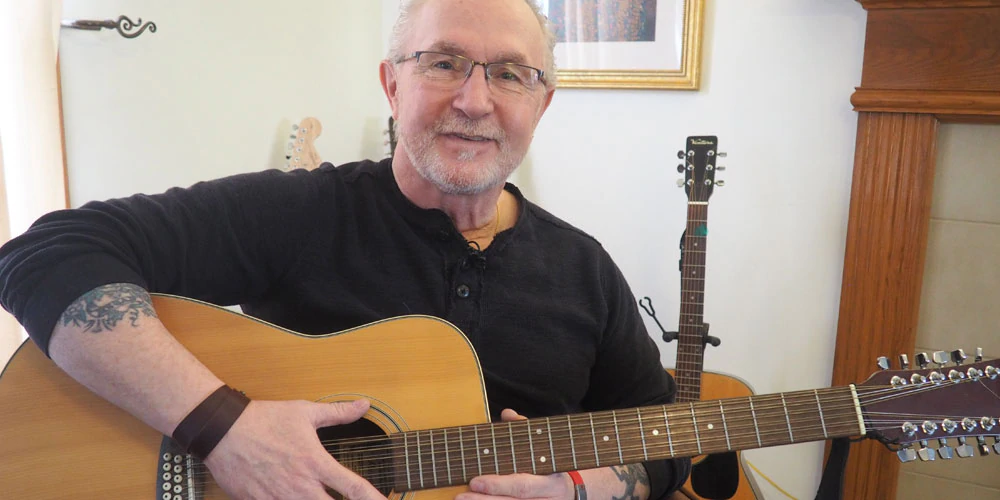A Non-Opioid Option for Chronic Pain
Medtronic spinal cord stimulation can be an effective non-opioid treatment for chronic intractable pain.
Parks is one of as many as 100 million Americans who suffer from chronic pain.
September 2018 - Erwin “Skip” Parks never thought he could become a drug addict.
“It was devastating to realize that I was addicted to something,” he said.
For Parks, 60, and millions of other Americans1, that “something” is pain medication, prescribed by doctors to help him manage chronic pain.
At its worst, he says a pain score of 10 out of 10 wasn’t really descriptive of his severe pain. “I was immobile. I couldn’t do anything,” he said.
Parks served nearly 20 years as an engineer in the Navy. A series of military-related back injuries led to several back surgeries and left him disabled. Over the years, doctors prescribed higher and higher doses of opioids for the intense pain, but the increased medication did not control Skip’s pain.
Eventually, Skip realized “I'm still in pain, there's got to be something else I can do.” That’s when his doctors recommended he try spinal cord stimulation.
At OhioHealth in Columbus, Dr. Chris Karas implanted the Medtronic Intellis™ device low on the left side of Skip’s back. Wires, or leads, run from the rechargeable device and are placed over areas of the spinal cord, delivering tiny electric impulses to treat the pain.
“We see pain relief immediately in most patients,” said Dr. Karas. “And we see functional improvement in a very short period, usually within a week or two, although not every patient experience is exactly the same.”
“I’ve gone from a 10-plus to about a 6, so for me, that’s huge,” Parks said. “Six, I can live with.”
Underutilized Technology
Parks is one of as many as 100 million Americans who suffer from chronic pain.1 Often treated with opioids, it’s estimated up to 29 percent of those pain patients misuse the drugs that are supposed to help them.2
Dr. Michael Bourn served on a governor’s task force to address Ohio’s opioid crisis. He says technology solutions like spinal cord stimulation should be considered more often in treating chronic pain. “I would say that it is underutilized to a great degree,” he said. “While I don’t think spinal cord stimulation is a panacea, it fits well into a multi-modal pain management strategy, especially if opioid sparing is our goal,” he said.
There was a time when even lifting a camera was too painful for Skip Parks. But today, he says spinal cord stimulation has allowed him to get back to living a full life. “It’s given me the ability to be me again,” he said.
“The thing I missed most was being able to hold my wife at night. It’s been years,” he added. “With Intellis, I’m able to make some adjustments and roll over, lay on my side, and actually wrap my arms around my wife again. It’s an amazing thing.”
IMPORTANT SAFETY INFORMATION
A Medtronic implantable neurostimulation system is indicated as an aid in the management of chronic, intractable pain of the trunk and/or limbs.
Implantation and use of a neurostimulation system involves risks including infection, paralysis, lead movement, pain at the implant site, jolting or shocking and loss of therapy effect. For a list of adverse events that have been associated with the therapy, please refer to important safety information at TameThePain.com/safety-neurostimulation.
The medical procedure diathermy cannot be used on someone with an implanted neurostimulation device, as this can result in severe injury or death. Most electrical devices and magnets encountered in a normal day are unlikely to affect the operation of a neurostimulator. However, sources of strong electromagnetic interference, such as MRI and RF/microwave ablation, can interact with the neurostimulation system, resulting in serious injury or device damage.
Not everyone responds to spinal cord stimulation in the same way, and your experience may vary. To understand the benefits and risks, please discuss them in detail with your doctor. A prescription is required.
For complete safety information about spinal cord stimulation for chronic pain, call Medtronic at 1-800-510-6735 or visit the Medtronic website at TameThePain.com/safety-neurostimulation.
1WebMD: https://www.webmd.com/pain-management/news/20110629/100-million-americans-have-chronic-pain#1
2Vowles KE, McEntee ML, Julnes PS, Frohe T, Ney JP, van der Goes DN. Rates of opioid misuse, abuse, and addiction in chronic pain: a systematic review and data synthesis. Pain. 2015;156(4):569-576. doi:10.1097/01.j.pain.0000460357.01998.f1.
